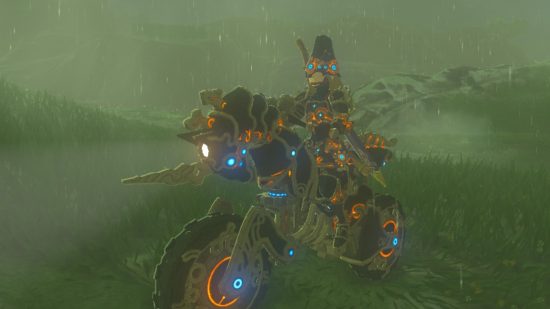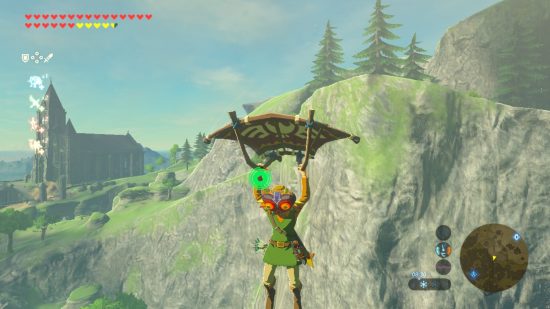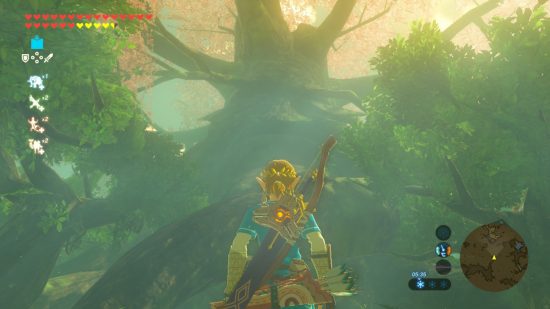Our Verdict
Though Tears of the Kingdom may be a better game, they offering distinctively unique experiences, and Breath of the Wild mustn't be forgotten, as it remains a tremendous open-world adventure that will forever be a turning point for the Zelda series.
You’re probably wondering why I’m writing The Legend of Zelda: Breath of the Wild review in 2023 when Tears of the Kingdom has only just come out and everybody is loudly singing its praises. I think this is the perfect time to talk about its prequel. There will no doubt be a lot of gamers for whom TotK is their first Zelda game, and I’m sure a lot of people will be wondering whether or not they should be playing Breath of the Wild too.
As to the question of whether BotW is still worth playing on the Nintendo Switch, I’m not going to make you get to the bottom of the article to find out; it’s a yes. But as a Zelda fan, I am biased. I think the original Game Boy version of Link’s Awakening is still worth playing, in spite of the Switch remake. I think both versions of Ocarina of Time and Majora’s Mask are still worth playing. I even think the Zelda Game & Watch is still worth playing, so of course I think a unique, comprehensive experience like BotW is worth playing.
Obviously, everyone likes games for different reasons, so I’m going to break it down and go over every aspect of the game, weighing up what it does well, and also giving a point of comparison to TotK, where appropriate.
Story
There’s no denying that the multi-pronged timeline that connects all the older Zelda games is a little confusing (and no doubt, off-putting for some), so it was kind of cool for Breath of the Wild to just be set an enormous length of time afterward. You didn’t need to know anything about what happened in the earlier games, but there were still plenty of little references and Easter Eggs for longtime fans to look out for.
In this one, Link wakes up from a one hundred years’ sleep and finds Hyrule in ruins, with Ganon (now a shapeless, mindless evil) having control of Hyrule Castle (and Zelda trapped within). After a brief tutorial, you can do whatever you want, whether that’s testing your abilities and heading straight to Ganon, or hunting for shrines to gain more health and stamina, or just exploring, chatting to NPCs, picking up side-quests, and looking for secrets.
When it came out, it felt quite epic, for it to be this really distant part of the timeline, coming after Ganon had lost all of his intelligence, Link and Zelda had already failed to stop him once, and Hyrule had been left in ruins. Though it’s not this final, distant point that it once was, the set-up is really cool, and the freedom to face the final boss whenever you want is unique, with Tears of the Kingdom presenting Link with a more nuanced quest.
While it can fairly be said that the BotW story is rather simple, if you take the time to discover all of the BotW memory locations, you can unlock several cutscenes which give the game a rather compelling backstory. There’s plenty of it for you to find if you so desire.
Map
Most readers will probably already know that Breath of the Wild and Tears of the Kingdom use the same map, though TotK expands it with sky islands to explore high in the sky, and other areas that we won’t spoil in case you don’t know about them yet. Knowing this, you might think that the BotW doesn’t have much to offer map-wise, that you can’t get from TotK.
I don’t think that’s true though. Years ago, Pokemon Gold and Silver surprised players by allowing them to go and visit the Kanto region from Pokemon Red and Blue after they’d finished going through the new Johto region. Did this mean that those who had never played the first generation of Pokemon games had no reason to go and play the originals? No. And it’s the same for TotK and BotW.
Just as with Kanto, when your return to Hyrule in TotK, you get to see how the years have changed the land and its inhabitants. For me, it was really cool to see all of those changes, but if you’ve never played BotW that aspect will be lost on you. However, you can get that experience in reverse: a chance to see how the world was in an earlier state.
With some places damaged by the coming of the Gloom, BotW gives you a chance to see what they were like before. On the flip side, with Hyrule mostly in ruins in BotW, you get to see what the land was like before they’d started to rebuild and repair in TotK. These things really help to make Hyrule feel like a tangible location that changes over time (just as many older Zelda games did in smaller ways).
If you’re a fan of world-building and environmental storytelling, then seeing the earlier map of BotW is definitely something you’re going to want to do.
Gameplay
This is probably the main area where BotW will seem lacking when compared to TotK. BotW Link cannot build things by sticking different materials together, and he also can’t reverse time, or swim upward through ceilings. For those who are creatively inclined, this will probably be pretty disappointing. There are smaller ways that you can ‘build’ things, but nothing that comes close to what you can do in TotK.
Having said that, what BOTW does have, is the Sheika Slate. With this, Link has a completely different set of abilities in his arsenal, such as the ability to instantly create pillars of ice out of water, the ability to summon a bomb at any time, or the ability to freeze something in time (with the ability to attack it multiple times, so the impact of all those blows is released at once).
Many of the Sheikah Slate abilities can kind of be recreated using different resources in TotK, but with the exception of Magnesis (which is made redundant by newer abilities), you don’t have these available to use whenever you want. This means that the way you approach puzzles in both games is going to be very different, as Link in each game has a different set of skills to bring to the table.
This is probably the biggest thing that distinguishes BotW and TotK. As someone who played a huge number of hours in BotW first, whenever I entered a shrine in TotK, my mind was hardwired (to some extent) to think in terms of the abilities Link had in the previous game. It’s such a different experience, and, in my mind, this is a big reason to still play BotW after TotK.
In terms of the freedom to walk around and explore the game as you see fit, it’s pretty much the same. Though one thing that you’ll notice is that in BotW, you’ll find a much larger variety of weapons lying around for you to use (though, of course, there’s no option to customize them with different items and resources), which is pretty cool (though not really a weakness of TotK).
TotK provided one pretty major quality-of-life feature that BotW really would have benefited from. On-screen at all times, you have a mini-map that shows you the direction of the markers on your map. Though I’m sure that there are some players who appreciate being lost in the wilderness unaided by a mini-map (instead of having to pause to check the full map), I, at least, would find it hard to adapt to the pre-mini-map days of BotW after TotK.
As a final note, the DLC for BotW gives Link the chance to get a motorbike (the Master Cycle Zero) and then ride it around the Hylian plains. This isn’t in TotK, and though you can build loads of vehicles of your own, it still would have been cool for the Master Cycle to show up again.
Graphics
As someone who regularly plays NES, Game & Watch, and Game Boy games, I am no snob when it comes to graphics. Having said that, I think BotW looks absolutely fantastic. Kind of like a Studio Ghibli movie turned into a 3D landscape. Other games that strove for a more realistic look in 2017 haven’t aged as well, but BotW’s art style means that it still looks good even now.
Admittedly, TotK does look better, but only fractionally. Unless you’re consciously trying to compare them, you’d probably think of them as looking pretty much the same. There are small things, like moss on the walls, and so on, which help TotK look even nicer than BotW, but I would be very surprised if anyone who thought TotK looked good, also thought BotW looked bad.
Enemies and bosses
Zelda games have always been known for their selection of weird and wonderful enemy creatures. One of the biggest criticisms rightly directed towards BotW is that it didn’t have a lot of enemy variety. It is very true that there’s a small handful of enemies that you’ll encounter again and again, without a huge amount of variety based on different areas of the map (e.g. mountains, deserts, snowy wastelands, etc.) For me, this never got to the point where I was bored or fed up by the enemy selection, but I did find myself yearning for encounters with things like ReDeads or Like Likes, which both return to TotK.
Players who started with TOTK will no doubt find the smaller pool of enemies a little disappointing. They do all look a bit different in BotW compared to TotK, so at least you’ll have that to stop it from feeling like you’re just seeing a portion of TotK’s enemies.
Music
When BotW came out, there were definitely those who felt that the game’s soundtrack wasn’t up to the same standard as those which came before. I disagree, I think it’s a different type of soundtrack for a different type of game. The music created by the game’s composers, Manaka Kataoka, Yasuaki Iwata, Hajime Wakai, does an excellent job of highlighting the beauty and solitude of the Hylian wilderness.
I don’t want to directly compare the soundtrack of BotW against TotK, because music is such a subjective thing, but I think both sound fantastic. It’s exactly the kind of music you’d want to hear while taking Link on a hike across the enormous Hylian fields, and at times you’re just left with the ambient sound of nature, and that’s great too.
As an aside, BotW was the game that gave us Kass’ Theme, which is such a beautiful bit of music.
Final Verdict
The Legend of Zelda: Breath of the Wild is probably not quite as good as Tears of the Kingdom, but it’s a different game trying to do something different. It will always be a game with historic significance, because it will always be the first Zelda game to use the style of gameplay which, we’re sure, will continue to be used in many future games.
Though it has a lot in common with TotK, that doesn’t mean that they’re both trying to do the same thing. When the TotK developers were making the game, I don’t think their thought process was “Let’s do the same thing, but better” but rather “How can we turn this winning formula into something new?”
So if you’re new to the series through TotK and want more of this setting world, definitely go back and play BotW. Though it’s new and popular for now, once the dust has settled, I’m confident that there’ll be a group of fans championing BotW as the superior of the two.
I won’t be one of them, but I can see that it’s different enough, that some people will just naturally prefer the way of things in BotW. Either way, it deserves to always be remembered as one of the best Zelda games, and will always have a special place in my heart.


